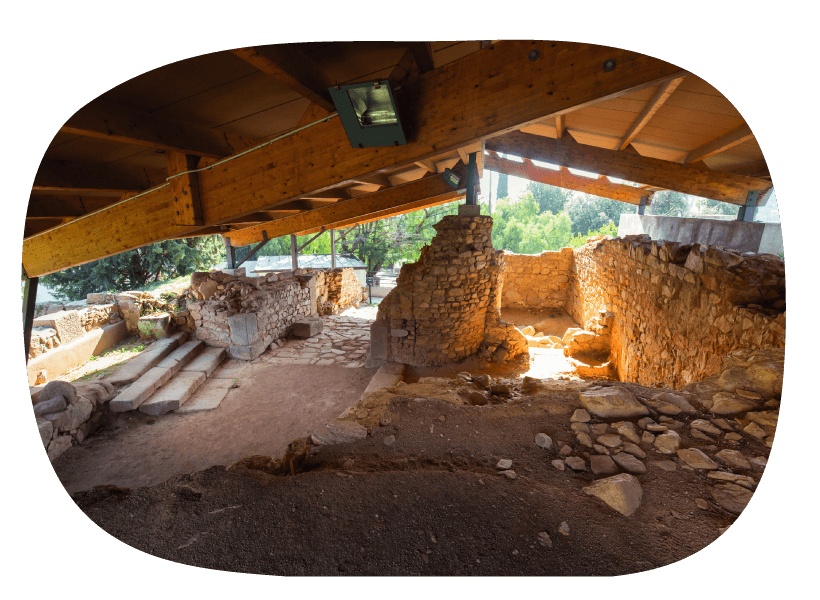Route 7: Argentona - Dosrius - Òrrius - Cabrera de Mar

1. SANTUARI DEL CORREDOR
2. POU DE GLAÇ
3. TURÓ DELS CÈLLECS
4. FONTS D'ARGENTONA
5. MUSEU DEL CÀNTIR

MUSEU DEL CÀNTIR (WATER JUG MUSEUM)
This museum is unique in the world in its specialty, although in Spain we can find another two collections of private jars open to the public: the Museum of Botijo de Villena (Alicante) and Toral de los Guzmanes (León).
The collections of the Argentona-based Water Jug Museum are made up of more than four thousand pieces ranging from the Bronze Age to Picasso, passing through large collections of ceramics from the 14th to the 18th centuries, numerous pieces from the 19th century and the main part of the collection, made up of popular and traditional clay from the entire 20th century.
The origin of pieces is very diverse, but mainly come from Catalonia and Spain, although in recent years numerous pieces from other countries have joined in, such as Portugal, France, Italy, Morocco, Mexico and Peru, among many others.
Les col·leccions del Museu del Càntir d'Argentona estan formades per més de quatre mil exemplars que van de l'Edat de Bronze a Picasso, passant per grans col·leccions de terrissa de volta dels segles XIV al XVIII, nombrosos exemplars del segle XIX iael gruix de la col·lecció, format per terrissa popular i tradicional de tot el segle XX.
La seva procedència és molt diversa, però sobretot se centre a Catalunya i l'Estat espanyol, tot i que els darrers anys han ingressat nombrosos exemplars d'altres països com Portugal, França, Itàlia, el Marroc, Mèxic i Perú, entre molts altres.

THE LEGEND OF REPATRUGES
Legend has it that Juliana was the protagonist of an event that originated the bad name by which the Argentonians are known for:
On that day, ecclesiastical and civil authorities met with a large flock of parishioners at the church square for the arrival of the Bishop who was coming from the neighbouring city of Mataró to make a Pastoral visit to the parish. In order to know the very moment, the bishop was entering the town, it had been agreed with the bellman that after he saw the dust of the carriage, a sign of the arrival of an illustrious personality, he would start tolling the bells.
And so, it was done, when the bellman saw the cloud of dust that the vehicle raised passing at more or less the height of the chapel of the Holy Christ, hanged on the strings of the bells, and started to toll them.
The authorities and neighbours headed towards Cap de Creus to pay tribute to the prelate, but ... oh what a misfortune and surprise! It turned out to be a carriage carrying a pair of sows on its way to the Granollers market!

6. CASTELL DE BURRIAC

CASTELL DE BURRIAC (BURRIAC CASTLE)
The Burriac mountain, with the ancient castle's rubble on its summit, defines the unmistakable landscape of the village of Cabrera, together with Montcabrer Castle. Its height (401 m) and location make it an unbeatable point of surveillance and control over the extensive territory of the valley of Cabrera and a good part of the Maresme region, as well as over the Argentona stream and Parpers mountain pass, an important means of communication between the coast and the inland region. For this reason, the Iberians and later the Romans used its summit as a place of surveillance.
The tower and the walls that we find today are the remains of the medieval castle, originally known by the name of San Vicente and later by Burriac. It is a magnificent example of a rock castle, that is, directly incorporates natural rock outcrops into its defences to such an extent that the rock formations define the structure of the castle.
The Lord of Burriac Castle, Pere Joan Ferrer, never got used to living there, as he preferred the comforts of Vilassar Castle, which was more important and located within the town walls. In the absence of the lord, it was the so-called "castlà" who lived in the castle and administered it under his name. But in the 15th century the lord of the castle decided to settle down there and remodelled it; he expanded it and gave it a more residential use opening windows and making the rooms more diaphanous.
The castle has two main enclosures: the upper enclosure (top one) and the lower enclosure (bottom one). Together they form two lines of defence so that, if the lower enclosure was conquered by the enemy one could still fight resistance on the upper enclosure
Inside the castle we can distinguish different areas, according to their function:
- Tower of Homage: It was the most important part of the castle and the most noticeable one. It is named after the homage ceremony that took place in it, a solemn ceremony with which a man recognizes that he is the servant of a lord and promises him fidelity in exchange for a feudal grant.
- Weapons courtyard.
- Chapel.
- Chambers: These were the rooms where the feudal lords lived.
- Cistern: In order to provide themselves with water, the inhabitants of the castle had to collect rainwater or fetch it from the fountains located in the valley. In case of siege, the inhabitants of the area took refuge in the castle, so it was very important to have a good supply of drinking water. The large cistern is in the lower enclosure and there is a smaller one in the upper enclosure, next to the Tower of Homage. In modern times, the popular tradition has interpreted the remains of these cisterns as dungeons for the condemned.
- Warehouses and paintings: As in the case of water, the castle had to be provided with food to withstand a long siege, and perhaps this was the main function of the rooms located to the northern bastion. Also, in this area, next to the entrance door, there were the horse stables
- Southern bastion.
7. JACIMENT ARQUEOLÒGIC DE CAN MODOLELL (ARCHAEOLOGICAL SITE OF CAN MODOLELL)

Come and take part in the Laietania Festival, when the municipalities of the region schedule guided and dramatized tours to learn more about all these ancestors. Will you join me?

Do you know who god Mitra was?

JACIMENT ARQUEOLÒGIC DE CAN MODOLELL (ARCHAEOLOGICAL SITE OF CAN MODOLELL)
Can Modolell, the old Can Lledó, is a farmhouse located in the north of Cabrera, on the road to Can Segarra. In its land, very close to the farmhouse, were discovered remains sites ranging from the Iberian period to the late Middle Ages. The most important remains of the complex are, however, the structures of what could have been a pagan temple dedicated to the Persian god Mitra. Precisely, dating from the second half of the 1st century AD, one arul (altar) dedicated to Kaut provides the oldest date for a Mithraic cult remains within the Iberian Peninsula.
The oldest findings of the complex consist of residual ceramics (4th century BC) belonging to the Iberian period. From there, a first construction phase is established that would go from 50 BC to the time of Augustus. The second would correspond to the time of Claudius, the third to the Lower Empire (late 2nd century or early 3rd century) and the fourth to the Late Ancient phase (late 5th century or very early 6th century). In the end, a Medieval phase is established with three cist burial grounds. Finally, we find a set of fifteen graves dated from the XII century, as well as walls that could belong to the temple of San Juan.
Since part of the site has yet to be excavated, there is still discussion about what its function might have been. At first, it was thought to have been a Roman villa, although this opened up to the possibility of a pagan temple. With the successive findings of elements of worship, especially of the solar god Mithra, it was gradually believed to be a sanctuary dedicated to this god. The last excavations carried out in 2011 seem to rule out the association with a villa. It seems clear that the shrine was not only dedicated to Mithra, since other divinities have also been found, perhaps related to him or independent ones: Neptune, perhaps a Silvanus and a goddess from the Roman Pantheon. The Christian assimilation of this pagan sanctuary with the cult of St. John is highly probable, although it has not been proven. The cult to the sun, Mitra, would have been later covered up by the invocation to the saint of the summer solstice and the celebration of the fire: San Juan (Saint John´s eve).

THE FARMHOUSE
It dates from the 16th-17th century and has the usual three-body structure from the Gothic, Renaissance and Neoclassical architectural elements. The farmhouse belonged to Lladó since the 16th century but is currently owned by the Modolell family. It seems that in the 11th century the farmhouse was called San Juan because in front of it there is a rubble that could belong to the church dedicated to Saint John the Baptist.







